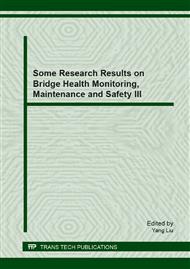[1]
Ayre RS, Jacobsen LS. Transverse vibration of a two-span beam under the action of a moving alternating force. J Appl Mech. 17(3) (1950) 283–90.
DOI: 10.1115/1.4010129
Google Scholar
[2]
Ayre RS, Ford G, Jacobsen LS. Transverse vibration of a two span beam under the action of a moving constant force. J Appl Mech. 17(1) (1950) 1–12.
DOI: 10.1115/1.4010050
Google Scholar
[3]
L.T. Oehler. Vibration Susceptibilities of Various Highway Bridges Types. ASCE, 83(3) (1957) 885-894.
Google Scholar
[4]
J. F. Wilson,Y. Wang,I. Threlfall. Responses of Near-optimal, Continuous Horizontally Curved Beams to Transit Loads. Journal of Sound and Vibration, 222(4) (1999)565-578.
DOI: 10.1006/jsvi.1998.2039
Google Scholar
[5]
Yang Y.B, Wu C.M, Yau J.D. Dynamic Response of a Horizontally Curved Beam Subjected to Vertical and Horizontal Moving Loads. Journal of Sound and Vibration. 242 (3) (2001) 519-537.
DOI: 10.1006/jsvi.2000.3355
Google Scholar
[6]
Iwase T, Hirashima K. I. Dynamic Responses of Multi-span Curved Beams with Non-uniform Section Subjected to Moving Loads. Trans JSME. 69(12) (2003) 1723-1730.
Google Scholar
[7]
Memory T. J, Thambiratnam D. P,Brameld G. H. Free vibration analysis of bridges, Journal of Engineering Structure, 17 (10) (1995) 705-713.
DOI: 10.1016/0141-0296(95)00037-8
Google Scholar
[8]
Y.T Qin, G..P Chen, Ling Yu. Dynamical modeling and response analysis of coupled vehicle-bridge system. J Appl Mech. 25(1) (2008) 129-132.
Google Scholar
[9]
Chun Zhang, Z.D Hu, Zheng ZHONG.. Vibration analysis for vehicle bridge interaction by Haar wavelet method. Journal of vibration and shock, 26(4) (2007) 77-82.
Google Scholar
[10]
G. H. Tan. Development of an analytical model for treating bridge-vehicle interaction. Engineering Structures, 20(1) (1998) 54-61.
DOI: 10.1016/s0141-0296(97)00051-5
Google Scholar
[11]
Z.X Li, F Chen. Analysis of interaction between vehicle and bridge with curved box girders. Engineering Mechanics. 24(11) (2007) 93-99.
Google Scholar
[12]
B.R Cheng, Y.X Zhou. Dynamic analysis of a coupled vehicle-bridge system using modal synthesis. J Tsinghua Univ (Sci & Tech), 42(8) (2002) 1083-1086.
Google Scholar
[13]
D.P Li, N.B Wang, Q.Y Zeng Coupling vibration analysis of variational coefficient vehicle-bridge system using modal synthesis. Journal Of Railway Science And Engineering. 6(3) (2009) 36-41.
Google Scholar
[14]
Bathe KJ. Finite element procedures in engineering analysis. Prentice-Hall, 1982.
Google Scholar
[15]
X.Y Huang, H.F Sheng, Y.J Chen, Y. Li. Triple-girder model for dynamic analysis of thin-walled box-girder bridges and experimental investigation. Journal of Vibration and Shock, 27(12) (2008) 40-45.
Google Scholar
[16]
Guyan RJ. Reduction of stiffness and mass matrices. AIAA J. 3(2) (1965) 380.
Google Scholar
[17]
R.W. Clough,J. Penzien. Dynamics of Structures. McGraw-Hill, New York, (1993)
Google Scholar
[18]
Hurty WC, Rubinstein MF. Dynamics of structures. Prentice-Hall,1960. p.90–103.
Google Scholar
[19]
ISO 8608. Mechanical vibration—Road surface profiles—reporting of measured data, 1995(E).
Google Scholar
[20]
K. Henchi, M. Fafardm, M. Talbot, G. Dhatt, An efficient algorithm for dynamic analysis of bridges under moving vehicles using a coupled modal and physical components approach, Journal of Sound and Vibration .212 (4) (1998) 663–683.
DOI: 10.1006/jsvi.1997.1459
Google Scholar
[21]
Chul Woo Kim, Mitsuo Kawatani, Ki Bong Kim. Three-dimensional Dynamic Analysis for Bridge–vehicle Interaction with Roadway Roughness. Computers and Structures, (83) (2005) 1627-1645.
DOI: 10.1016/j.compstruc.2004.12.004
Google Scholar


